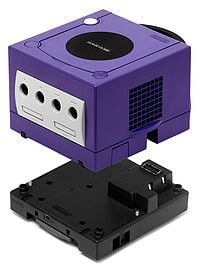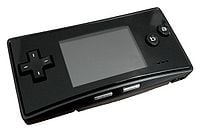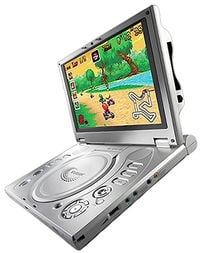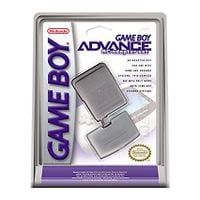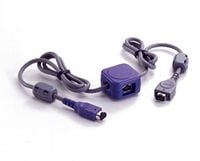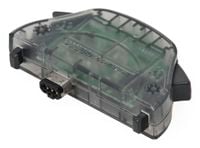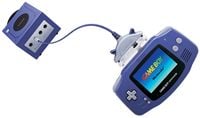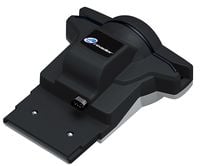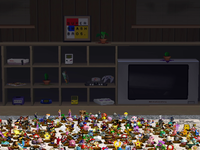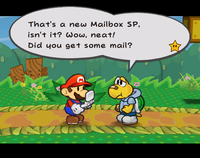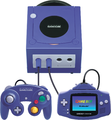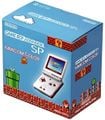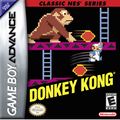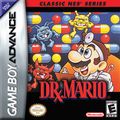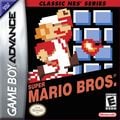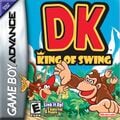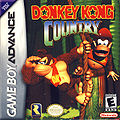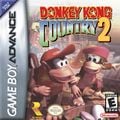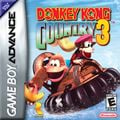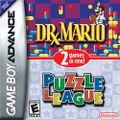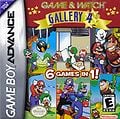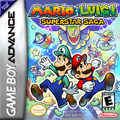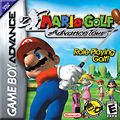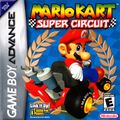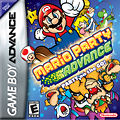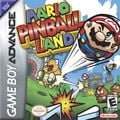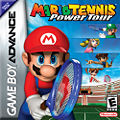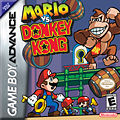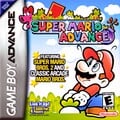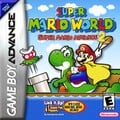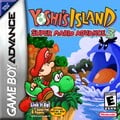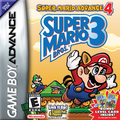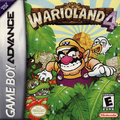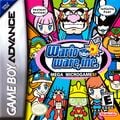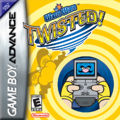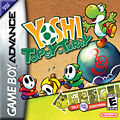Game Boy Advance: Difference between revisions
m (Text replacement - "''Mario'' series" to "''Super Mario'' franchise") |
m (Reverted edits by 190.105.160.8 (talk) to last revision by Bowserbros) Tags: Rollback Mobile edit Advanced mobile edit |
||
| (23 intermediate revisions by 15 users not shown) | |||
| Line 3: | Line 3: | ||
|image=[[File:GBA Handheld.png|300px]] | |image=[[File:GBA Handheld.png|300px]] | ||
|generation=Sixth | |generation=Sixth | ||
|release='''Game Boy Advance:'''<br>{{release|Japan|March 21, 2001|South Korea|June 2001<ref>Dailygame co, Ltd. (Apr 17, 2001) [http://www.dailyesports.com/view.php?ud=200104172217360003012 ''"대원씨아이, 닌텐도 게임보이 어드밴스 수입"''] ''데일리e스포츠''. Retrieved Aug 29, 2021.</ref>|USA|June 11, 2001|Europe|June 22, 2001|Australia|June 22, 2001<ref>@NintendoAUNZ (June 22, 2021). [https://twitter.com/NintendoAUNZ/status/1407168092505993223?s=20 ''"On this day 20 years ago, the Game Boy Advance was released in Australia and New Zealand. What's your favourite memory of this handheld console?"''] ''Twitter''. Retrieved June 22, 2021.</ref>|China|June 8, 2004}} '''Game Boy Advance SP:'''<br>{{release|Japan|February 14, 2003|Europe|March 23, 2003|Mexico|March 23, 2003<ref>[https://web.archive.org/web/20030401062006/http://nintendo.com.mx/ Official Mexican Website (Archived)]. Retrieved November 28, 2022.</ref>|USA|March 28, 2003|South Korea|April 2, 2003<ref>국, 순신. (Apr 1, 2003) [https://news.naver.com/main/read.naver?mode=LSD&mid=sec&sid1=105&oid=031&aid=0000020900 ''"닌텐도 게임보이 어드밴스SP 국내 출시"''] ''아이뉴스24''. Retrieved Aug 29, 2021.</ref>|Australia|April 10, 2003|China|October 27, 2004}} '''Game Boy Micro:'''<br>{{release|Japan|September 13, 2005|USA|September 19, 2005|Australia|November 3, 2005|Europe|November 4, 2005|South Korea|December 20, 2005<ref>박, 진호. (Dec 14, 2005) [https://www.gamemeca.com/view.php?gid=57332 ''"대원씨아이, 게임보이 마이크로 20일 국내 발매"''] ''게임메카''. Retrieved Aug 29, 2021.</ref>|China|March 23, 2006}} | |release='''Game Boy Advance:'''<br>{{release|Japan|March 21, 2001|South Korea|June 2001<ref>Dailygame co, Ltd. (Apr 17, 2001) [http://www.dailyesports.com/view.php?ud=200104172217360003012 ''"대원씨아이, 닌텐도 게임보이 어드밴스 수입"''] ''데일리e스포츠''. Retrieved Aug 29, 2021.</ref>|USA|June 11, 2001|Europe|June 22, 2001|Australia|June 22, 2001<ref>@NintendoAUNZ (June 22, 2021). [https://twitter.com/NintendoAUNZ/status/1407168092505993223?s=20 ''"On this day 20 years ago, the Game Boy Advance was released in Australia and New Zealand. What's your favourite memory of this handheld console?"''] ''Twitter''. Retrieved June 22, 2021.</ref>|South Africa|November 2002<ref>Rogers, Joshua Alexander (April 16, 2020). "[https://www.linkedin.com/pulse/video-games-around-world-south-africa-joshua-rogers/ Video Games around the World]". ''LinkedIn''. [https://web.archive.org/web/20220925153658/https://www.linkedin.com/pulse/video-games-around-world-south-africa-joshua-rogers/ Archived] from the original on September 25, 2022. Retrieved March 23, 2024.</ref>|China|June 8, 2004}} '''Game Boy Advance SP:'''<br>{{release|Japan|February 14, 2003|Europe|March 23, 2003|Mexico|March 23, 2003<ref>[https://web.archive.org/web/20030401062006/http://nintendo.com.mx/ Official Mexican Website (Archived)]. Retrieved November 28, 2022.</ref>|USA|March 28, 2003|South Korea|April 2, 2003<ref>국, 순신. (Apr 1, 2003) [https://news.naver.com/main/read.naver?mode=LSD&mid=sec&sid1=105&oid=031&aid=0000020900 ''"닌텐도 게임보이 어드밴스SP 국내 출시"''] ''아이뉴스24''. Retrieved Aug 29, 2021.</ref>|Australia|April 10, 2003|China|October 27, 2004}} '''Game Boy Micro:'''<br>{{release|Japan|September 13, 2005|USA|September 19, 2005|Australia|November 3, 2005|Europe|November 4, 2005|South Korea|December 20, 2005<ref>박, 진호. (Dec 14, 2005) [https://www.gamemeca.com/view.php?gid=57332 ''"대원씨아이, 게임보이 마이크로 20일 국내 발매"''] ''게임메카''. Retrieved Aug 29, 2021.</ref>|China|March 23, 2006}} | ||
|discontinued={{release|Japan|November 2008|Europe|October 16, 2009|USA|December 9, 2009|South Korea|2009}} | |discontinued={{release|Japan|November 2008{{ref needed}}|Europe|October 16, 2009{{ref needed}}|USA|December 9, 2009{{ref needed}}|South Korea|2009{{ref needed}}}} | ||
|predecessor=[[Game Boy Color]] | |predecessor=[[Game Boy Color]] | ||
|successor=[[Nintendo DS]] | |successor=[[Nintendo DS]] | ||
| Line 10: | Line 10: | ||
{{quote2|Who are you?|The Game Boy Advance slogan}} | {{quote2|Who are you?|The Game Boy Advance slogan}} | ||
[[File:GBAlogo.svg|left|250px]] | [[File:GBAlogo.svg|left|250px]] | ||
The '''{{wp|Game Boy Advance}}''' (also abbreviated as '''GBA''') is a 32-bit handheld game system created by [[Nintendo]]. It is the third and final system in the Game Boy series and is Nintendo's fourth handheld system. It has backwards compatibility with [[Game Boy]] and [[Game Boy Color]] games (making it the only Nintendo console to be backwards compatible with more than one system) and its accessories but no support for the GBC's IR Communication. The palette options are exactly the same as they are on the Game Boy Color. The Game Boy Advance line has sold 81.5 million units worldwide, according to Nintendo, and it was discontinued in 2008. The console's button configuration inherits the {{button|gba|A}}, {{button|gba|B}}, {{button|gba|start}}, and {{button|gba|select}} buttons as well as {{button|gba|Pad}} from the original Game Boy and Game Boy Color, but it introduces two additional buttons: the {{button|gba|L}} and {{button|gba|R}} buttons. Unlike [[Nintendo DS|its successor]], the standard Game Boy Advance does not have a backlit screen, so the player cannot see the screen in the dark without the use of external devices. The standard Game Boy Advance is the last handheld to require two AAs, as well as the last Nintendo handheld (along with its [[#Game Boy Micro|Game Boy Micro]] counterpart) until the [[Nintendo 3DS#Nintendo 2DS|Nintendo 2DS]] not to have a clamshell design. It was the handheld counterpart of the [[Nintendo GameCube | The '''{{wp|Game Boy Advance}}''' (also abbreviated as '''GBA''') is a 32-bit handheld game system created by [[Nintendo]]. It is the third and final system in the Game Boy series and is Nintendo's fourth handheld system. It has backwards compatibility with [[Game Boy]] and [[Game Boy Color]] games (making it the only Nintendo console to be backwards compatible with more than one system) and its accessories but no support for the GBC's IR Communication. The palette options are exactly the same as they are on the Game Boy Color. The Game Boy Advance line has sold 81.5 million units worldwide, according to Nintendo, and it was discontinued in 2008. The console's button configuration inherits the {{button|gba|A}}, {{button|gba|B}}, {{button|gba|start}}, and {{button|gba|select}} buttons as well as {{button|gba|Pad}} from the original Game Boy and Game Boy Color, but it introduces two additional buttons: the {{button|gba|L}} and {{button|gba|R}} buttons. Unlike [[Nintendo DS|its successor]], the standard Game Boy Advance does not have a backlit screen, so the player cannot see the screen in the dark without the use of external devices. The standard Game Boy Advance is the last handheld to require two AAs, as well as the last Nintendo handheld (along with its [[#Game Boy Micro|Game Boy Micro]] counterpart) until the [[Nintendo 3DS#Nintendo 2DS|Nintendo 2DS]] not to have a clamshell design. It was the handheld counterpart of the [[Nintendo GameCube]]. | ||
==Models== | ==Models== | ||
| Line 50: | Line 50: | ||
===Game Link Cable=== | ===Game Link Cable=== | ||
[[File:GBA Link Cable.jpg|thumb|left|Game Link Cable]] | [[File:GBA Link Cable.jpg|thumb|left|Game Link Cable]] | ||
The Game Link Cable was the primary way to connect 2-4 Game Boy Advances, allowing them to communicate with each other. The purple connector establishes which device is P1, the grey connector establishes which device is P2, while the purple box in the middle of the cable's length allows for a P3 and P4 to connect using additional Game Link Cables where only the purple connector fits. Many ''Mario'' games support single pak and multi pak game link modes, such as games from the [[Super Mario Advance (series)|''Super Mario Advance'' series]] where players can play a competitive 4-way ''[[Mario Bros. (game)|Mario Bros.]]'' game, even with ''[[Mario & Luigi: Superstar Saga]]'' and its copy of ''Mario Bros.'', although not all games required each player to have a Game Pak. The Game Link Cable can also be used with an [[e-Reader]], such as a primitive form of DLC for ''[[Super Mario Advance 4: Super Mario Bros. 3]]'' with the use of [[Super Mario Advance 4: Super Mario Bros. 3 e-Reader cards|compatible cards]]. | The Game Link Cable was the primary way to connect 2-4 Game Boy Advances, allowing them to communicate with each other. The purple connector establishes which device is P1, the grey connector establishes which device is P2, while the purple box in the middle of the cable's length allows for a P3 and P4 to connect using additional Game Link Cables where only the purple connector fits. Many ''Super Mario'' games support single pak and multi pak game link modes, such as games from the [[Super Mario Advance (series)|''Super Mario Advance'' series]] where players can play a competitive 4-way ''[[Mario Bros. (game)|Mario Bros.]]'' game, even with ''[[Mario & Luigi: Superstar Saga]]'' and its copy of ''Mario Bros.'', although not all games required each player to have a Game Pak. The Game Link Cable can also be used with an [[e-Reader]], such as a primitive form of DLC for ''[[Super Mario Advance 4: Super Mario Bros. 3]]'' with the use of [[Super Mario Advance 4: Super Mario Bros. 3 e-Reader cards|compatible cards]]. | ||
The extension port used to link two Game Boy Advances together is physically missing in the [[Nintendo DS]]. | The extension port used to link two Game Boy Advances together is physically missing in the [[Nintendo DS]]. | ||
| Line 84: | Line 84: | ||
===''Mario & Luigi: Superstar Saga''=== | ===''Mario & Luigi: Superstar Saga''=== | ||
The [[Game Boy Horror SP]] appears in ''[[Mario & Luigi: Superstar Saga]]'' as an item given to Mario and Luigi by [[Professor Elvin Gadd|Professor E. Gadd]]. It is a parody of the Game Boy Advance SP, and a reference to the [[Game Boy Horror]] from ''[[Luigi's Mansion]]'', which was modeled after the [[Game Boy Color]]. In addition, [[Bowletta]] sends messages to Beanbean Castle on original Game Boy Advance systems capable of projecting her image (purple the first time and orange the second time). | The [[Game Boy Horror SP]] appears in ''[[Mario & Luigi: Superstar Saga]]'' as an item given to Mario and Luigi by [[Professor Elvin Gadd|Professor E. Gadd]]. It is a parody of the Game Boy Advance SP, and a reference to the [[Game Boy Horror]] from ''[[Luigi's Mansion]]'', which was modeled after the [[Game Boy Color]]. In addition, [[Bowletta]] sends messages to Beanbean Castle on original Game Boy Advance systems capable of projecting her image (purple the first time and orange the second time); the game's [[Mario & Luigi: Superstar Saga + Bowser's Minions|3DS remake]] replaces these with [[Nintendo 3DS]] systems, which have the same function. | ||
===''Paper Mario: The Thousand-Year Door''=== | ===''Paper Mario: The Thousand-Year Door''=== | ||
| Line 92: | Line 92: | ||
===''Wario Land 4''=== | ===''Wario Land 4''=== | ||
[[File:WL4-Flashback7.png|frame| | [[File:WL4-Flashback7.png|frame|[[Wario]] holding a box filled with Game Boy Advance consoles]] | ||
In ''[[Wario Land 4]]'', many images of [[Gallery:Wario Land 4#Flashbacks|artwork]] appear in the game's ending credits. One of these images shows [[Wario]] with boxes full of Game Boy Advance consoles. | In ''[[Wario Land 4]]'', many images of [[Gallery:Wario Land 4#Flashbacks|artwork]] appear in the game's ending credits. One of these images shows [[Wario]] with boxes full of Game Boy Advance consoles. | ||
{{br}} | {{br}} | ||
| Line 105: | Line 105: | ||
====''WarioWare: Touched!''==== | ====''WarioWare: Touched!''==== | ||
In ''[[WarioWare: Touched!]]'', the Game Boy Advance makes various appearances. Both a Game Boy Advance and Game Boy Advance SP are stolen by Wario in the opening, a monitor shown during [[Mona]]'s stage resembles a Game Boy Advance, Game Boy Advances are thrown by the audience at [[Vanessa]] when she tries to disguise herself as [[Mona]], and a Game Boy Advance and Game Boy Advance SP appear in [[9-Volt]]'s intro cutscene. The microgame [[Stylus Hunt|Pushing Buttons]] contains a Game Boy Advance and a Game Boy Advance SP and [[Gold Digger]] features a pink Game Boy Advance. | In ''[[WarioWare: Touched!]]'', the Game Boy Advance makes various appearances. Both a Game Boy Advance and Game Boy Advance SP are stolen by Wario in the opening, a monitor shown during [[Mona]]'s stage resembles a Game Boy Advance, Game Boy Advances are thrown by the audience at [[Vanessa]] when she tries to disguise herself as [[Mona]], and a Game Boy Advance and Game Boy Advance SP appear in [[9-Volt]]'s intro cutscene. The microgame [[Stylus Hunt|Pushing Buttons]] contains a Game Boy Advance and a Game Boy Advance SP and [[Gold Digger]] features a pink Game Boy Advance. | ||
====''WarioWare Gold''==== | |||
The Game Boy Advance is a [[List of souvenirs in WarioWare Gold|souvenir]] in the Nintendo collection in ''[[WarioWare Gold]]''. | |||
==System gallery== | ==System gallery== | ||
<gallery> | <gallery> | ||
GBAlogoblack.svg|Game Boy Advance logo (black) | |||
Game Boy Advance Logo JP.png|Japanese logo | |||
GBA Group.jpg|Different colors of the Game Boy Advance | GBA Group.jpg|Different colors of the Game Boy Advance | ||
GCN-GBA Cable.jpg|GBA connected to the [[Nintendo GameCube|GameCube]] | GCN-GBA Cable.jpg|GBA connected to the [[Nintendo GameCube|GameCube]] | ||
GBA connected GCN.png|GBA and GameCube controller connected to the GameCube | GBA connected GCN.png|GBA and GameCube controller connected to the GameCube | ||
MARIOGBA.gif|A ''Mario''-themed GBA | MARIOGBA.gif|A ''Super Mario''-themed GBA | ||
Game-Boy-Advance-SP-Mk1-Blue.jpg|A Cobalt Blue Game Boy Advance SP | Game-Boy-Advance-SP-Mk1-Blue.jpg|A Cobalt Blue Game Boy Advance SP | ||
Gameboy-Advance-SP-Mk2.jpg|An Ice Blue Game Boy Advance SP | Gameboy-Advance-SP-Mk2.jpg|An Ice Blue Game Boy Advance SP | ||
Mario Commemorate Version iQue GBASP.jpg|A ''Mario''-themed [[iQue]] GBA SP released as part of the ''Super Mario'' 20th anniversary | Mario Commemorate Version iQue GBASP.jpg|A ''Super Mario''-themed [[iQue]] GBA SP released as part of the ''Super Mario'' 20th anniversary | ||
DiddyDixie.jpg|Diddy and Dixie playing a Game Boy Advance SP | DiddyDixie.jpg|Diddy and Dixie playing a Game Boy Advance SP | ||
GBA Startup.gif|Startup screen of the GBA. If no game is inserted, the "Nintendo" text will not appear. | GBA Startup.gif|Startup screen of the GBA. If no game is inserted, the "Nintendo" text will not appear. | ||
| Line 162: | Line 166: | ||
YTTboxart front.jpg|''[[Yoshi Topsy-Turvy]]'' | YTTboxart front.jpg|''[[Yoshi Topsy-Turvy]]'' | ||
</gallery> | </gallery> | ||
==References== | ==References== | ||
Revision as of 11:29, April 6, 2024
- This article is about the handheld gaming system. For the gamebook series of the same name, see Game Boy Advance (book series). For the treasure from Wario World, see List of treasures in Wario World § Beanstalk Way.
| Game Boy Advance | |
|---|---|
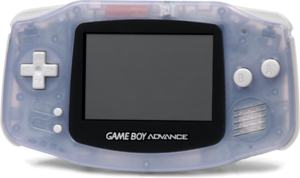
| |
| Generation | Sixth generation |
| Release date | Game Boy Advance: Game Boy Advance SP: Game Boy Micro: |
| Discontinued | |
| Predecessor | Game Boy Color |
| Successor | Nintendo DS |
- “Who are you?”
- —The Game Boy Advance slogan
The Game Boy Advance (also abbreviated as GBA) is a 32-bit handheld game system created by Nintendo. It is the third and final system in the Game Boy series and is Nintendo's fourth handheld system. It has backwards compatibility with Game Boy and Game Boy Color games (making it the only Nintendo console to be backwards compatible with more than one system) and its accessories but no support for the GBC's IR Communication. The palette options are exactly the same as they are on the Game Boy Color. The Game Boy Advance line has sold 81.5 million units worldwide, according to Nintendo, and it was discontinued in 2008. The console's button configuration inherits the ![]() ,
, ![]() ,
, , and
buttons as well as
![]() from the original Game Boy and Game Boy Color, but it introduces two additional buttons: the
from the original Game Boy and Game Boy Color, but it introduces two additional buttons: the ![]() and
and ![]() buttons. Unlike its successor, the standard Game Boy Advance does not have a backlit screen, so the player cannot see the screen in the dark without the use of external devices. The standard Game Boy Advance is the last handheld to require two AAs, as well as the last Nintendo handheld (along with its Game Boy Micro counterpart) until the Nintendo 2DS not to have a clamshell design. It was the handheld counterpart of the Nintendo GameCube.
buttons. Unlike its successor, the standard Game Boy Advance does not have a backlit screen, so the player cannot see the screen in the dark without the use of external devices. The standard Game Boy Advance is the last handheld to require two AAs, as well as the last Nintendo handheld (along with its Game Boy Micro counterpart) until the Nintendo 2DS not to have a clamshell design. It was the handheld counterpart of the Nintendo GameCube.
Models
Game Boy Advance SP
The Game Boy Advance SP (Game Boy Advance Special) is an upgraded version of the original GBA first released in 2003. The serial code was AGS-001. It featured a new design, with a clamshell style and frontlit screen. It also came with a rechargeable battery for the first time. Although it lacks a headphone jack, official or third-party adapters can be inserted into the charging port to use headphones. In 2005, Nintendo also released upgraded backlit versions colored Pearl Blue and Pearl Pink. This upgraded backlit model had the serial code AGS-101, unlike the former Game Boy Advance SP. The Game Boy Advance SP sold 43.55 million units worldwide. This system also had backwards compatibility with the Game Boy and the Game Boy Color while the palette options found on the Game Boy Color can be used on original Game Boy games. There is a special version of the SP that looked like a Nintendo Entertainment System. It was also the last handheld to have backwards compatibility with the Game Boy and Game Boy Color games. The Game Boy Advance SP was discontinued in 2008.
Game Boy Player
- Main article: Game Boy Player
The Game Boy Player was an add-on accessory for the Nintendo GameCube which allowed players to play Game Boy Advance games on their televisions and thus functioned similarly to the Super Game Boy. It also has backwards compatibility with Game Boy and Game Boy Color games and the palette options are still the same as they are on the Game Boy Color, Game Boy Advance and Game Boy Advance SP. A few games had a rumble feature which took effect only when they were played with a standard GameCube controller.
Game Boy Micro
The Game Boy Micro is the third design of the GBA that was first released in 2005. At a size of only 10 cm (4 inches) wide, two inches tall, less than an inch deep, and a weight of 79 grams (2.8 ounces), it is smaller than any other system in the Game Boy line, about the size of a NES controller. Its screen is slightly smaller than that of the GBA and SP, but it maintains the same resolution. Unlike its predecessors, it is not backwards-compatible with the Game Boy or the Game Boy Color. It came with an adjustable backlight for playing in the dark, and players could buy plastic "skins" in addition to those with which it was packaged in order to change the Game Boy Micro's appearance. A 20th anniversary edition was released to honor the anniversary of the NES. The Game Boy Micro did not sell well, having only sold 2.42 million units worldwide in contrast to the Game Boy Advance SP having sold 34.32 million units worldwide as of mid-2005.
The Game Boy Micro would be the final single-screen handheld produced by Nintendo until the Nintendo Switch Lite, released fourteen years later.
In 2008, the Game Boy Micro was discontinued.[7]
Visteon Dockable Entertainment System
The Visteon Dockable Entertainment System is a combination of a portable DVD Player and a Game Boy Advance. Sold at car dealerships, the console is notable for running Game Boy Advance games, as Visteon partnered with Nintendo to announce the product at CES 2006. This console was included with a wireless game controller, wireless headphones, a Game Boy Advance cartridge slot, and a remote control. It was even backward compatible with audio CDs.
Accessories
AC Adapter
To use AC power, the first model had a special adapter that goes over the battery compartment. This was obsoleted with the release of the Game Boy Advance SP and its rechargeable battery and AC adapter.
Game Link Cable
The Game Link Cable was the primary way to connect 2-4 Game Boy Advances, allowing them to communicate with each other. The purple connector establishes which device is P1, the grey connector establishes which device is P2, while the purple box in the middle of the cable's length allows for a P3 and P4 to connect using additional Game Link Cables where only the purple connector fits. Many Super Mario games support single pak and multi pak game link modes, such as games from the Super Mario Advance series where players can play a competitive 4-way Mario Bros. game, even with Mario & Luigi: Superstar Saga and its copy of Mario Bros., although not all games required each player to have a Game Pak. The Game Link Cable can also be used with an e-Reader, such as a primitive form of DLC for Super Mario Advance 4: Super Mario Bros. 3 with the use of compatible cards.
The extension port used to link two Game Boy Advances together is physically missing in the Nintendo DS.
Wireless Adapter
This allows wireless communication between multiple Game Boy Advance units, only between compatible games including Classic NES Series, Mario Golf: Advance Tour, and Mario Tennis: Power Tour. One came bundled with each copy of Pokémon FireRed and LeafGreen, excluding Player's Choice re-releases.
If no cartridge is inserted (or +
are held) during the BIOS boot sequence, special software will boot. This software works similarly to local game lobbies by finding and listing all lobbies within range, similarly to the successor Nintendo DS.
Nintendo GameCube–Game Boy Advance Link Cable
This cable connects a Game Boy Advance to the Nintendo GameCube. The kind of set up is the successor to the Transfer Pak of the Nintendo 64. The Game Boy Player is compatible with it, making the attached Game Boy Advance serve as a controller for the GameCube running in Game Boy Advance mode. Some games utilize data transfer between a GameCube and Game Boy Advance games, such as connecting games Mario Golf: Advance Tour, Mario Golf: Toadstool Tour, and Nintendo Puzzle Collection.
e-Reader
- Main article: e-Reader
The e-Reader is an add-on device for the Game Boy Advance released in 2002. It can scan cards to add new features to Game Boy Advance games and had some classic games as well. However, in 2004, it was discontinued outside Japan due to poor sales.
Appearances in the Super Mario franchise
Luigi's Mansion
In Luigi's Mansion, there is a Boo called "Game Boo" and another that asks if Luigi wants to play "GameBoo Advance."
Super Smash Bros. Melee
In Super Smash Bros. Melee, it appears when viewing all the trophies at once.
Mario & Luigi: Superstar Saga
The Game Boy Horror SP appears in Mario & Luigi: Superstar Saga as an item given to Mario and Luigi by Professor E. Gadd. It is a parody of the Game Boy Advance SP, and a reference to the Game Boy Horror from Luigi's Mansion, which was modeled after the Game Boy Color. In addition, Bowletta sends messages to Beanbean Castle on original Game Boy Advance systems capable of projecting her image (purple the first time and orange the second time); the game's 3DS remake replaces these with Nintendo 3DS systems, which have the same function.
Paper Mario: The Thousand-Year Door
In Paper Mario: The Thousand-Year Door, a Game Boy Advance is used as the terminal at the Glitz Pit, where Mario and his party set up their matches. Additionally, Mario carries with him an e-mail device called the "Mailbox SP," which resembles a Game Boy Advance SP. A humorous in-dialogue reference is made by Pennington if Mario should ask his opinion on what Bub wants for his birthday; the Bumpty confidently assumes it is a Game Boy Advance, being "what young children his age crave above all things!" A Toad in Petalburg says he has been playing a game called Fire Emblem on his GBA, a reference to another game series also developed by Intelligent Systems.
Wario Land 4
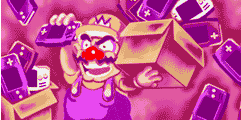
In Wario Land 4, many images of artwork appear in the game's ending credits. One of these images shows Wario with boxes full of Game Boy Advance consoles.
Wario World
In Wario World, one of the treasures Wario needs to get out the Pink Chest located in Beanstalk Way is a Game Boy Advance; however, the player can't interact with it.
WarioWare series
WarioWare: Twisted!
In WarioWare: Twisted!, the Game Boy Advance makes an appearance at the beginning and end. In the intro cutscene, Wario plays on his Game Boy Advance, before taking it to Dr. Crygor to fix it, and in the intro of Wario-Man's story, one of the many objects on the conveyor belt is a Game Boy Advance.
WarioWare: Touched!
In WarioWare: Touched!, the Game Boy Advance makes various appearances. Both a Game Boy Advance and Game Boy Advance SP are stolen by Wario in the opening, a monitor shown during Mona's stage resembles a Game Boy Advance, Game Boy Advances are thrown by the audience at Vanessa when she tries to disguise herself as Mona, and a Game Boy Advance and Game Boy Advance SP appear in 9-Volt's intro cutscene. The microgame Pushing Buttons contains a Game Boy Advance and a Game Boy Advance SP and Gold Digger features a pink Game Boy Advance.
WarioWare Gold
The Game Boy Advance is a souvenir in the Nintendo collection in WarioWare Gold.
System gallery
GBA connected to the GameCube
A Super Mario-themed iQue GBA SP released as part of the Super Mario 20th anniversary
European bundle, with Super Mario World: Super Mario Advance 2 included
Game Boy Advance SP Famicom color version box art (Japanese)
Game Boy Micro Famicom version box art (Japanese)
Media
| File info |
Game gallery
References
- ^ Dailygame co, Ltd. (Apr 17, 2001) "대원씨아이, 닌텐도 게임보이 어드밴스 수입" 데일리e스포츠. Retrieved Aug 29, 2021.
- ^ @NintendoAUNZ (June 22, 2021). "On this day 20 years ago, the Game Boy Advance was released in Australia and New Zealand. What's your favourite memory of this handheld console?" Twitter. Retrieved June 22, 2021.
- ^ Rogers, Joshua Alexander (April 16, 2020). "Video Games around the World". LinkedIn. Archived from the original on September 25, 2022. Retrieved March 23, 2024.
- ^ Official Mexican Website (Archived). Retrieved November 28, 2022.
- ^ 국, 순신. (Apr 1, 2003) "닌텐도 게임보이 어드밴스SP 국내 출시" 아이뉴스24. Retrieved Aug 29, 2021.
- ^ 박, 진호. (Dec 14, 2005) "대원씨아이, 게임보이 마이크로 20일 국내 발매" 게임메카. Retrieved Aug 29, 2021.
- ^ Vega, N. (March 13, 2017). A look back at the Game Boy Micro, the Nintendo console that time forgot. Business Insider. Retrieved December 16, 2019.

